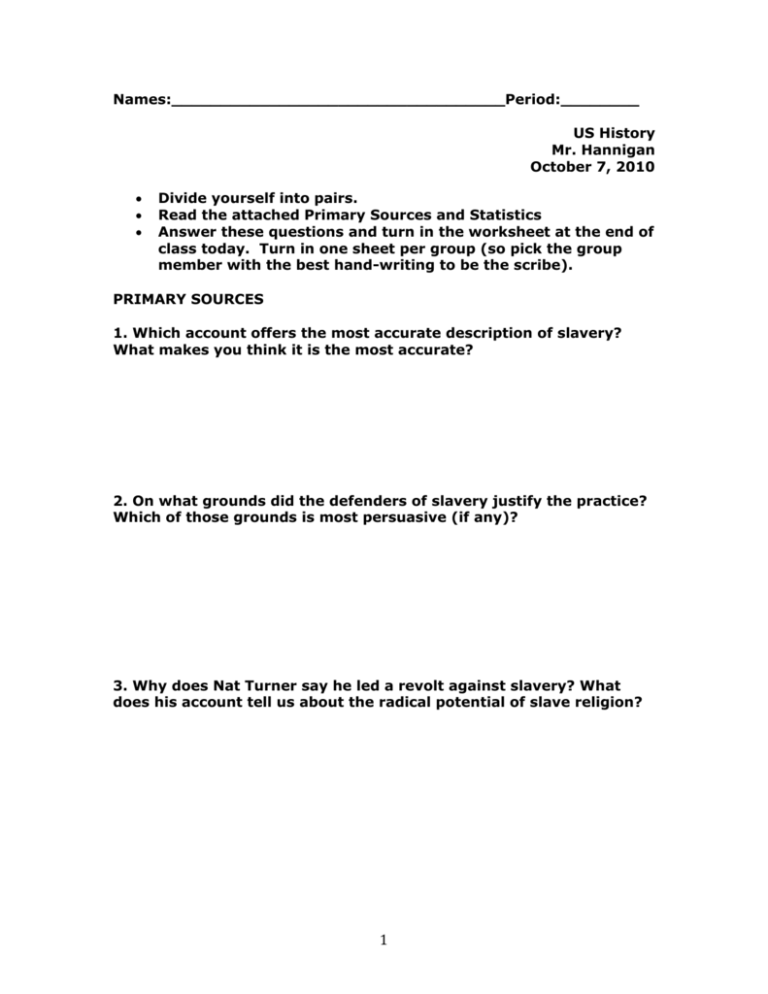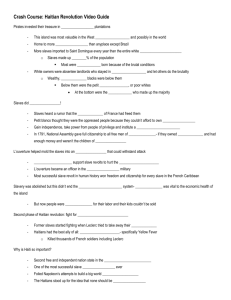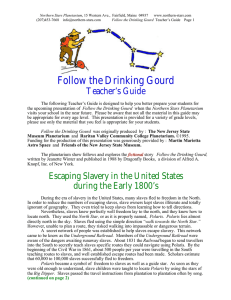Slavery Primary Document Exercise
advertisement

Names:__________________________________Period:________ US History Mr. Hannigan October 7, 2010 Divide yourself into pairs. Read the attached Primary Sources and Statistics Answer these questions and turn in the worksheet at the end of class today. Turn in one sheet per group (so pick the group member with the best hand-writing to be the scribe). PRIMARY SOURCES 1. Which account offers the most accurate description of slavery? What makes you think it is the most accurate? 2. On what grounds did the defenders of slavery justify the practice? Which of those grounds is most persuasive (if any)? 3. Why does Nat Turner say he led a revolt against slavery? What does his account tell us about the radical potential of slave religion? 1 STATISTICS 1. How many slaves did most white Southerners own? 2. On what size farm or plantation did a typical slave live? How many slave families might have lived on such a plantation? How likely was it that a slave could find a spouse on a plantation of that size? 3. How rapidly was the slave population growing? Why do you think the U.S. slave population grew while the slave populations elsewhere in the New World failed to naturally reproduce their numbers? 2 Reading 1: The whole commerce between master and slave is a perpetual exercise of the...most unremitting despotism on the one part, and degrading submissions on the other.....Indeed I tremble for my country when I reflect that God is just; that his justice cannot sleep forever. -Thomas Jefferson, 1782 Reading 2: An hour before day light the horn is blown. Then the slaves arouse, prepare their breakfast, fill a gourd with water, in another deposit their dinner of cold bacon and corn cake, and hurry to the field again. It is an offense invariably followed by a flogging, to be found at the quarters after daybreak.... The hands are required to be in the cotton field as soon as it is light in the morning, and, with the exception of ten or fifteen minutes, which is given them at noon to swallow their allowance of cold bacon, they are not permitted to be a moment idle until it is too dark to see, and when the moon is full, they often times labor till the middle of the night. They do not dare to stop even at dinner time, nor return to the quarters, however late it be, until the order to halt is given by the driver.... Finally, at a late hour, they reach the quarters, sleepy and overcome with the long day's toil. All that is allowed them is corn and bacon, which is given out at the corn-crib and smoke-house every Sunday morning. Each one receives, as his weekly allowance, three and a half pounds of bacon, and corn enough to make a peck of meal. That is all. -Solomon Northrup, 1853 Reading 3: The laborers begin work at six o'clock in the morning, have an hour's rest at nine for breakfast, and many have finished their assigned task by two o'clock, all of them by three o'clock. In summer, they divide their work differently, going to bed in the middle of the day, then rising to finish their task, and afterward spending a great part of the night in chatting, merrymaking, preaching, and psalm-singing.... The laborers are allowed Indian meal, rice, and milk, and occasionally pork and soup. As their rations are more than they can eat, they either return part of it at the end of the week, or they keep it to feed their fowls, which they usually sell, as well as their eggs, for cash, to buy molasses, tobacco, and other luxuries.... The sight of the whip was painful to me as a mark of degradation, reminding me that the lower orders of slaves are kept to their work by mere bodily fear, and that their treatment must depend on the individual character of the owner or overseer. -Sir Charles Lyell, 1845-49 3 Reading 4: The Negro slaves of the South are the happiest, and, in some sense, the freest people in the world. The children and the aged and infirm work not at all, and yet have all the comforts and necessaries of life provided for them. They enjoy liberty, because they are oppressed neither by care nor labor. The women do little hard work, and are protected from the despotism of their husbands by their masters. The Negro men and stout boys work, on the average, in good weather, not more than nine hours a day....Besides they have their Sabbaths and holidays. The free laborer must work or starve. He is more of a slave than the Negro, because he works longer and harder for less allowance than the slave, and has no holiday, because the cares of life with him begin when its labor end. He has no liberty, and not a single right. -George Fitzhugh, Cannibals All or Slaves Without Masters, 1857 Reading 5: On the 12th of May, 1828, I heard a loud noise in the heavens, and the Spirit instantly appeared to me and said the Serpent was loosened, and Christ had laid down the yoke he had borne for the sins of Men, and that I should take it on and fight against the Serpent, for the time was fast approaching when the first should be last and the last should be first. Question: Do you not find yourself mistaken now? Answer: Was not Christ crucified? Since 1830, I had been living with Mr. Joseph Travis, who was a kind master who had placed great trust in me. On Saturday evening, August 20th [1831] we decided to meet the next day for a meal and to work out our plan of attack....It was quickly agreed we should start at home (Mr. J. Travis') on that night. I took my station in the rear, and, as it was my object to carry terror and destruction wherever we went, I placed fifteen or twenty of the best armed and most to be relied on in front, who generally approached the houses as fast as their horses could run. This was for two purposes--to prevent their escape and strike terror to the inhabitants. -Confessions of Nat Turner, 1831 Reading 6: Follow the Drinking Gourd When the sun comes back and the first quail calls, Follow the drinking gourd. for the old man is a-waiting for to carry you to freedom, If you follow the drinking gourd The river bank will make a very good road, 4 The dead trees show you the way. Left foot, peg foot traveling on, Follow the drinking gourd. -Negro spiritual Slaves and Slaveholdings Slaveholding, 1860 Non-slaveholders 76.1 percent 1-9 slaves 17.2 percent 10-99 6.6 percent over 100 0.1 percent Distribution of Slaves Number of slaves held 0 1-6 7-39 40+ Percent of white families 75 15 9 1 Percent of slaves held 0 16 53 31 Growth of the African American Population 1820 1.77 million 13 percent free 1830 2.33 million 14 percent free 1840 2.87 million 13 percent free 1850 3.69 million 12 percent free 1860 4.44 million 11 percent free 5









